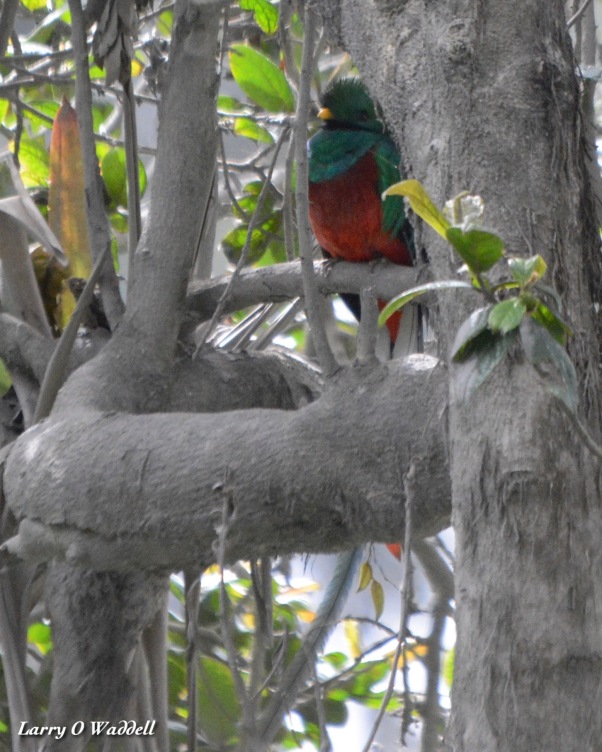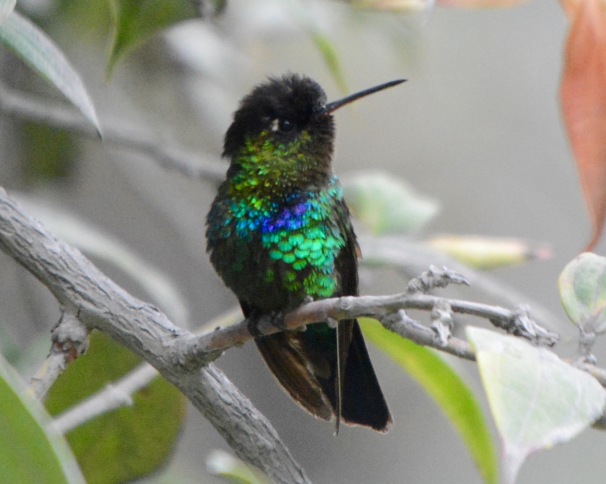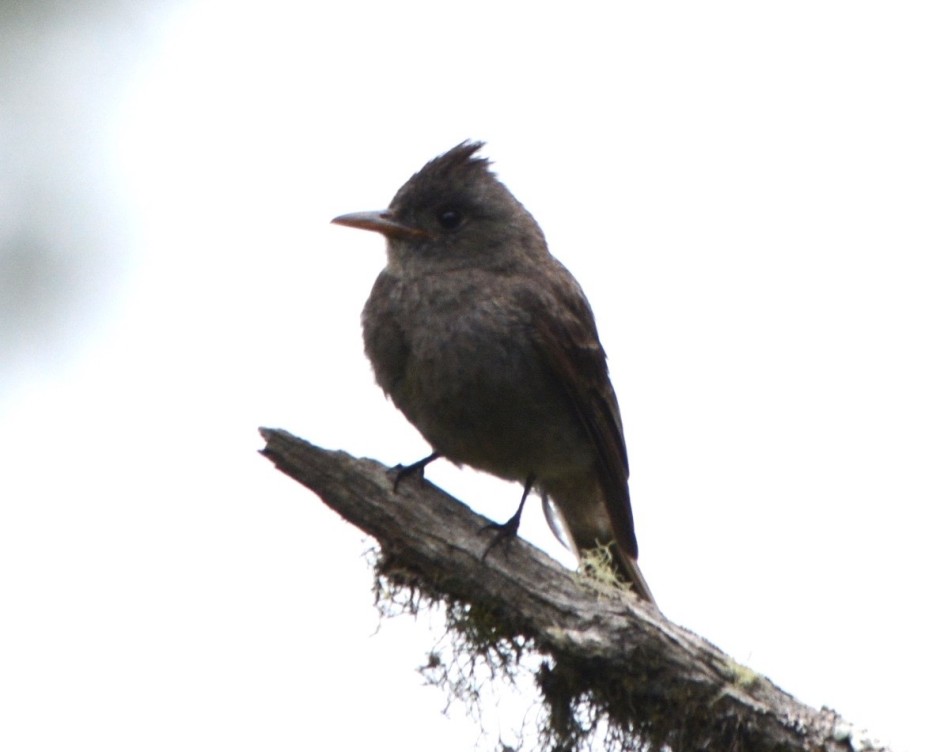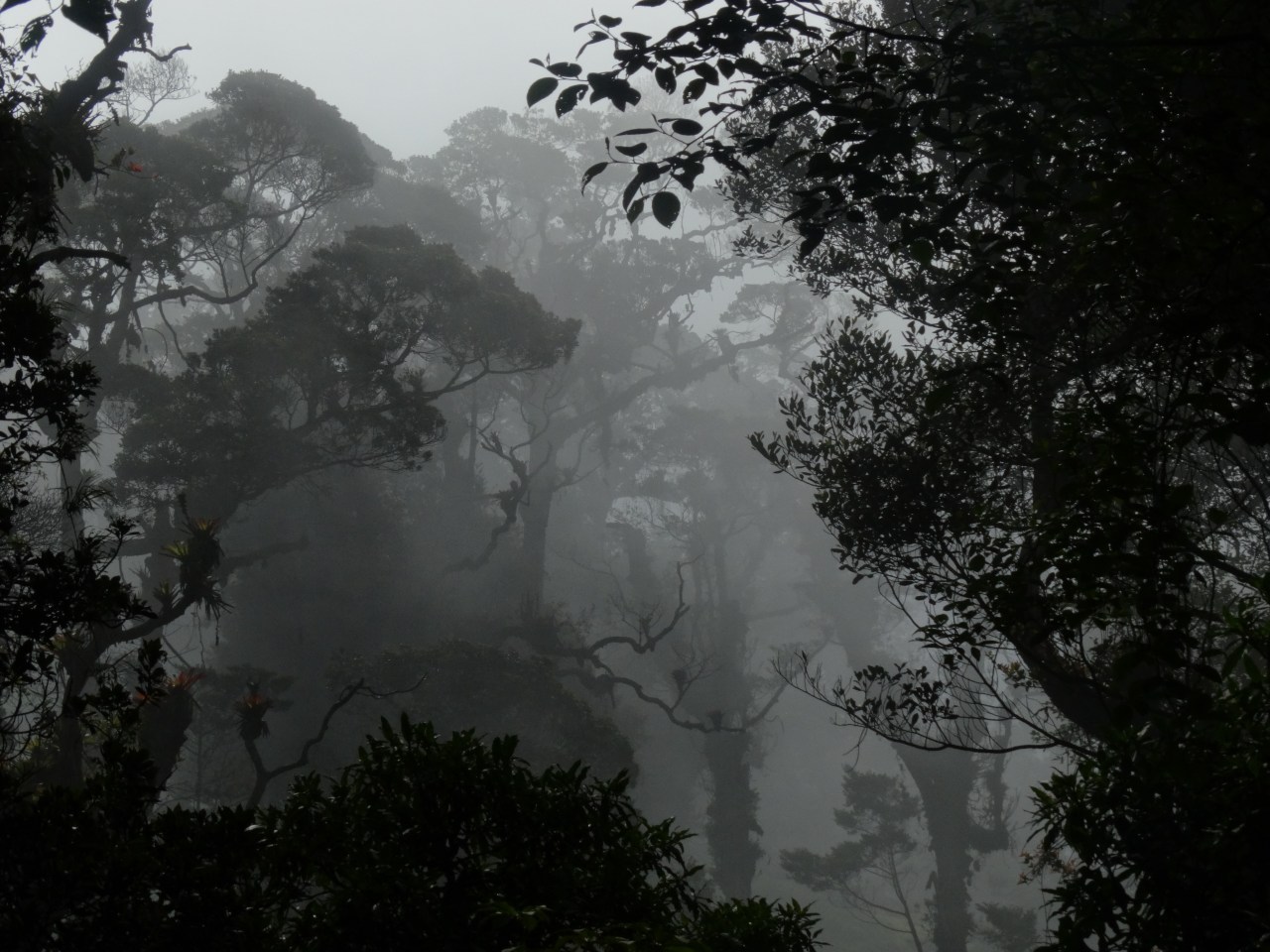April, and beautiful weather on the Turrialba Volcano slope: a perfect combination for making the Resplendent Quetzal our target bird for the day.

View from El Tapojo, obscured by the mountain mist
Larry and I set off early but in bright sunshine for La Pastora, the village at which the Turrialba Volcano road begins. A pair of Tropical Mockingbirds (Mimus gilvus) were the first sighting of the day. This species is yet another invader from the north and is now spreading rapidly throughout the country. Like its North American counterpart, the Northern Mockingbird, it associates closely with man and often nests close to human habitation.

Tropical Mockingbird now seems established at La Pastora
Our good start was compounded when we found three Mourning Doves (Zenaida macroura) picking up gravel on the road. This too is a species that I have seen only recently in the Turrialba area, despite the fact that its main area of residence in Costa Rica is not so far away, near Cartago on the slopes of the Irazú Volcano.
When we reached El Tapojo at around 2800 m our chances of success became reduced by clouds and mist and we recorded less than 20 different species in a period of several hours. Most of these, however, were high-elevation birds such as Sooty Thrush, Black Guan and Black-and-yellow Silky-Flycatcher that you will simply not find lower down.
In addition, our walk uphill towards the volcano crater from El Tapojo was a reward in itself, passing as it does through magnificent cloud forest.

Quetzal habitat above El Tapojo
Larry’s photo above shows very exactly in what kind of scenery we then found our first Resplendent Quetzal (Pharomachrus mocinno) of the day. It always takes a little bit of luck to find this species. It blends in totally with its thick forest habitat, and since it spends long periods between its meals of avocadillo and other fruits sitting and waiting inconspicuously in a dark environment, it is very easy to overlook. This is true despite the beautiful green-and-red plumage, and in the case of the male, the magnificent green train of feathers that can extend the bird’s 14 inch length by as much as another 30 inches.

Try as he might, Larry couldn’t get all of the male Resplendent Quetzal‘s train (which here appears white) into the picture
In Costa Rica, this species is actually reasonably common within its range. Most birders visiting the country can head for the quetzal country around Cerro de la Muerte or the Dota region, where guides will escort them to a site at which it is known in advance a quetzal will be found. This is easily done without even straying far from a paved road. Despite the uncertainty of our cloud-forest trek, I find it far preferable to stumble across this marvelous creature when far from the crowds of photographers that sometimes assemble at the famous “quetzal lodges”. But then, I have the luxury of living here and being able to head up towards the Turrialba Volcano at any time! A tourist with only limited time in the country will feel very well rewarded by any opportunity to see the Resplendent Quetzal.

This male Resplendent Quetzal posed nicely but it’s a wonder that Larry could get any photograph at all!
The glimpses that we were afforded in the forest mist gave little opportunity for photographs but as we made our way back down to El Tapojo we were lucky enough to see very briefly another male. We suspected that females were close by but could make no confirmed sighting.
Even if you don’t find a quetzal on the Turrialba Volcano slope, there are lots of other fine species to be seen while enjoying hauntingly beautiful scenery, even if it rains! A final photograph from this day at El Tapojo is of a typical highland thrush, the Black-billed Nightingale-Thrush (Catharus gracilirostris):

Slender and pretty: the Black-billed Nightingale-Thrush often hops close at ground level
Hummingbirds abounded, though we found only 5 different species. Up at El Tapojo, the typical hummers are the endlessly chirping Lesser Violetear (formerly Green Violetear) (Colibri thalassinus), the blue-black-tailed Fiery-throated Hummingbird (Panterpe insignis):

The fiery throat is not so easily seen, neither here….

nor here.
and the tiny Volcano Hummingbird (Selasphorus flammula). Photographs of hummingbirds were easier to take lower down on the volcano road, where the weather was more cooperative. At slightly lower elevations, the Purple-throated Mountain-Gem (Lampornis calolaemus) is easy to find:

In this case, the female is even prettier than the male.
The last strikingly beautiful bird of the day was the Long-tailed Silky-flycatcher (Ptilogonys caudatus):

This species sometimes descends to our village of San Antonio in search of berries, in particular fruta de paloma
Nearby we also found this Contopus, which we fancy is a highland species, the Dark Pewee (Contopus lugubris). Can anyone help to confirm the identification?

Special thanks to Larry for these images because he now has an enforced absence from Costa Rica. He will return towards the end of this year together with the rest of the northern migrants!


Great last trip for the season Paul, sorry I can’t help you out on the dark pewee anymore than I could when we saw it. Fun trip and glad you could use the photos.
LikeLike
See you in Minnesota!
LikeLike